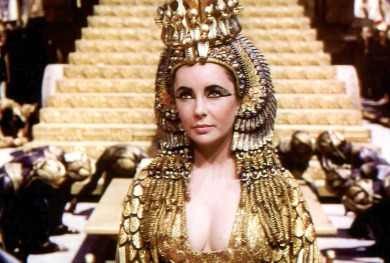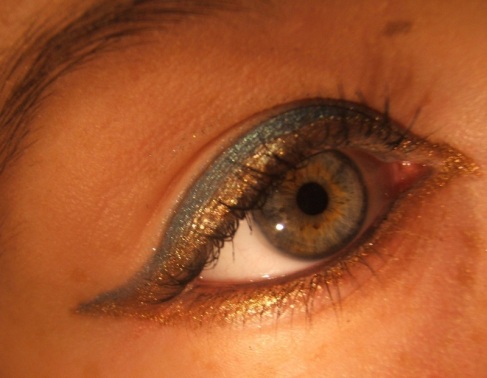Make-Up was first used in Ancient Rome for ritual purposes,were part of daily life for women, especially prostitutes and the wealthy. Cosmetics were sometimes given to prostitutes as payment from some customers. Cosmetics from China, Germany and Gaul, were so expensive that the Lex Oppia tried to limit their use in 189 BCE. These “designer brands” spawned cheap knock-offs that were sold to poorer women.Working-class women could afford the cheaper varieties, but may not have had the time (or slaves) to apply the makeupas the use of makeup was a time-consuming affair because cosmetics needed to be reapplied several times a day due to weather conditions and poor composition.
Cosmetics were applied in private, usually in a small room where men did not enter. Cosmetae, female slaves that adorned their mistresses, were especially praised for their skills.They would beautify their mistresses with cultus, the Latin word encompassing makeup, perfume and jewelry
Scent was also an important factor of beauty. Women who smelled good were presumed to be healthy. Due to the stench of many of the ingredients used in cosmetics at the time, women often drenched themselves in copious amounts of perfume. All cosmetic ingredients were also used as medicines to treat various ailments. Lead, although known to be poisonous, was still widely used.
 Pure white skin, a demarcation of the leisure class, was the most important feature of Roman beauty.Native Roman women weren’t naturally fair-skinned and spent their time outside with oils on their faces, requiring whitening makeup to fit their model of beauty.
Pure white skin, a demarcation of the leisure class, was the most important feature of Roman beauty.Native Roman women weren’t naturally fair-skinned and spent their time outside with oils on their faces, requiring whitening makeup to fit their model of beauty.
Women would often prepare their faces with beauty masks prior to applying makeup. One recipe called for the application of sweat from sheep’s wool to the face before bedtime,emitting a stench often criticized by men.Other ingredients included juice, seeds, horns, excrement, honey, plants, placenta, marrow, vinegar, bile, animal urine, sulphur, vinegar,eggs, myrrh, incense, frankincense,ground oyster shells,onions with poultry fat, white lead, and barley with vetch. Bathing in asses’ milk was an expensive treatment that worked like a chemical peel and was used by wealthy women such as Cleopatra VII and Poppaea Sabina.
After their baths, they would then apply face whitener, such as chalk powder,white marl, crocodile dung and white lead.The Roman recognition that lead was poisonous underscored their point of view on how important white skin was. Other ingredients used in whiteners included beeswax, olive oil, rosewater, saffron,animal fat, tin oxide, starch,rocket, cucumber, anise, mushrooms, honey, rose leaves, poppies, myrrh, frankincense,almond oil, rosewater, lily root, water parsnip and eggs.
The Romans disliked wrinkles, freckles, sunspots, skin flakes and blemishes.To soften wrinkles, they used swans’ fat, asses’ milk, gum Arabic and bean-meal.Sores and freckles were treated with the ashes of snails.
With the exception of hair on her head, hair was considered to be unattractive on a Roman woman. Consequently, women removed hair by either shaving, plucking, stripping using a resin paste, or scraping with a pumice stone. Older women faced ridicule for their depilation because it was viewed primarily as preparation for sex.
Eye Makeup
The ideal eyes, from the Roman perspective, were large with long eyelashes. Pliny the Elder wrote that eyelashes fell out from excessive sex and so it was especially important for women to keep their eyelashes long to prove their chastity.
Kohl was the main ingredient in eye makeup, and was composed of ashes or soot and antimony, with saffron usually added to improve the smell. Kohl was applied using a rounded stick, made of ivory, glass, bone, or wood, that would be dipped in either oil or water first, before being used to apply the kohl.The use of kohl as makeup came from the east. In addition to kohl, charred rose petalsand date stones could be used to darken the eyes.
Colored eyeshadow was also applied by women to accentuate their eyes. Green eyeshadow came from poisonous malachite, while blue came from azurite. The Romans preferred dark eyebrows that almost met in the center.This effect was achieved by darkening their eyebrows with antimony or soot and then extending them inward. Plucking began in the 1st century BCE to tidy their overall look.
HERE’S 12 FUN ANCIENT BEAUTY TIPS: (DO NOT ATTEMPT THESE AT HOME!)
1. Lovely ladies of the Middle East used to grind up lead – which causes metal poisoning – and apply it to their lashes, eyebrows and eyelids.
2. In ancient Babylonia, unwanted facial hair was sanded off with a rough pumice stone.
3. Women in Edwardian England would gladly swallow a slimy tapeworm to keep themselves slim and trim. The parasite would digest most of the food the women ate, and it also destroyed their health.
4. Eating arsenic was another way to achieve beauty discovered by Englishwomen. The deadly poison – used in the 19th century – gave the skin an interesting glow while it shortened the life span.
5. Beautiful blonde highlights in the hair were achieved by Venetian ladies who poured lion urine on their tresses before sitting out in the sun.
6. Early Japanese geishas and Kabuki actors used nightingale droppings to remove the thick make-up from their faces. 
7. Roman ladies rubbed brown seaweed on their faces as rouge, which did them no harm. But the white powder made from lead they rubbed on their faces gave them a slow death by lead poisoning as surely as it delighted their admirers.
8. Italian ladies of the past used to apply deadly nightshade to enhance their eyes. The poison dilates the pupils and makes people’s peepers look enormous and glowing.
9. Arabian ladies loved sleek and shiny hair, so they used camel urine to dip their raven-black hair in.
10. In the England of Queen Elizabeth I, great beauties of the time owed the rich red color of their lips to bugs. The squashed remains of insects were rubbed on the mouth for a ruby-red luster.
11. Face painting with white lead powder was also popular in Elizabeth’s time. The beauty secret caused the premature demise of a number of 16th century lovelies.
12. Crocodile dung made into a paste with donkey’s milk kept Cleopatra’s skin looking lovely in the Egyptian heat. She used it as a face mask – when Caesar wasn’t around.


